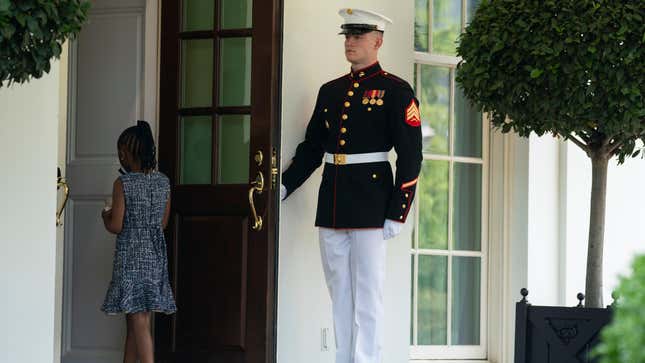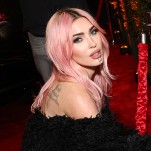
Photo: Evan Vucci
On Wednesday, Associated Press photographer Evan Vucci posted a photo of a Marine holding a White House door open for Gianna Floyd, daughter of George Floyd, whose death at the hands of Minneapolis police officer Derek Chauvin one year ago sparked worldwide protests. Gianna was in attendance with the rest of her family, lawyer Benjamin Crump and his team—and, for some reason, rapper Lil Baby—all there to meet with President Joe Biden and Vice President Kamala Harris. There, they pressed for the passage of the George Floyd Justice in Policing Act, a slew of police reforms that include federal restrictions on the use of force, a national database on police misconduct, and limiting qualified immunity.
But it was Vucci’s photo, and the responses it produced, that overshadowed much of the internet chatter over a bill that is languishing in the Senate after passing in the House.
“This photo is amazing, she looks like she lives there the way she’s going through that door by herself,” wrote one Twitter user. “The level of respect that this shows is wonderful as well.” Marines always stand guard outside of the West Wing doors and are tasked with opening them for visitors, so this photo doesn’t depict respect as much as it depicts duty. But someone concurred, replying, “May she one day lead us all.”
“The best part is she doesn’t think this is special or that she’s different —she’s just going in to see her friend. I hope she calls him Papa Joe,” read another comment. The fanfiction continued in several other tweets, like this: “And then Gianna ran into President Biden’s arms, asked him if he had any snacks cause she was hungry. Ice cream and cheetos were served to the child who knows her daddy changed the world.”
Singer and famed Twitter liberal Nancy Sinatra tweeted, “I hope someone will frame this photograph for Gianna. RESPECT.”
There were also several comparisons made to Norman Rockwell’s famed painting The Problem We All Live With, which depicts a young Ruby Bridges en route to desegregating an all-white public school in New Orleans, surrounded by men who protect her from violence implied by the racial slur written across the wall in the background. It’s a strange comparison, but one that certainly makes sense for those who have cast Gianna as something of a Civil Rights icon like Bridges was, instead of a child whose father was murdered by police. In reality, both were simply young Black girls whose lives were impacted by structural violence and racial discrimination. But accepting that requires an ability to regard Black children as children instead of as symbols.
-

-

-

-

-

-

-

-

-

-

-

-

-

-

-

-

-

-

-

-

-

-

-

-

-

-

-

-

-

-

-

-

-

-

-

-

-

-

-

-








































